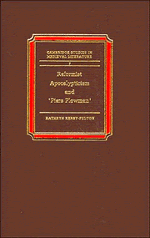Book contents
- Frontmatter
- Contents
- Acknowledgments
- List of abbreviations
- 1 Introduction
- 2 The visionary prophecy of Hildegard of Bingen in relation to Piers Plowman
- 3 Piers Plowman and the medieval visionary tradition
- 4 Leaven of malice: false apostles in the anti-mendicant apocalypticism of later medieval England
- 5 Leaven of hope: new leadership and Joachite apocalypticism
- 6 Conclusions
- Notes
- Select bibliography
- General index
- Index of biblical citations
- Index of manuscripts
3 - Piers Plowman and the medieval visionary tradition
Published online by Cambridge University Press: 15 October 2009
- Frontmatter
- Contents
- Acknowledgments
- List of abbreviations
- 1 Introduction
- 2 The visionary prophecy of Hildegard of Bingen in relation to Piers Plowman
- 3 Piers Plowman and the medieval visionary tradition
- 4 Leaven of malice: false apostles in the anti-mendicant apocalypticism of later medieval England
- 5 Leaven of hope: new leadership and Joachite apocalypticism
- 6 Conclusions
- Notes
- Select bibliography
- General index
- Index of biblical citations
- Index of manuscripts
Summary
INTRODUCTION: THE APOCALYPTIC VISIONARY TRADITION
In this chapter we will examine some of the literary features of the Hildegardian tradition of visionary writing, beginning with the pre-medieval apocalypse genre. Hildegard, who is probably the single most influential figure in the development of a Northern European apocalyptic visionary tradition, was consciously imitated by later visionary writers. The tracing of the Northern tradition is made all the more difficult because, unlike Southern visionary writing, it has never really been studied as a coherent tradition, largely because no study of Hildegard's influence exists. However, when entering upon such uncharted territory, it is reassuring to note that medieval writers and readers were aware of the development of this kind of visionary literature, even if modern scholarship has largely neglected it.
In 1513 the philosopher and theologian Jacques Lefèvre d'Etaples published the Liber trium virorum & trium spiritualium virginum as part of his campaign to make medieval spiritual works available to a larger public. Among the works he printed were visions by Hildegard, Elizabeth of Schönau, the anonymous Shepherd of Her mas and the visions of the Dominican Robert of Uzès. All six works were visions or revelations and it is clear that Lefevre had a strong sense that they formed a literary and spiritual tradition (Dronke, “Arbor”, p. 221). It is also clear that he felt that the publication of visions required some justification, or even defense, especially the publication of visions by women. Anticipating their detractors he asks, “Will they deny such revelations, because they themselves have never experienced them? Will the owl dispute with the eagle about the radiance of the sun and moles deny the beauty of the day?” Lefèvre's defensiveness reflects medieval sensitivity about this controversial and idiosyncratic genre, an issue which,
- Type
- Chapter
- Information
- Reformist Apocalypticism and Piers Plowman , pp. 76 - 132Publisher: Cambridge University PressPrint publication year: 1990

